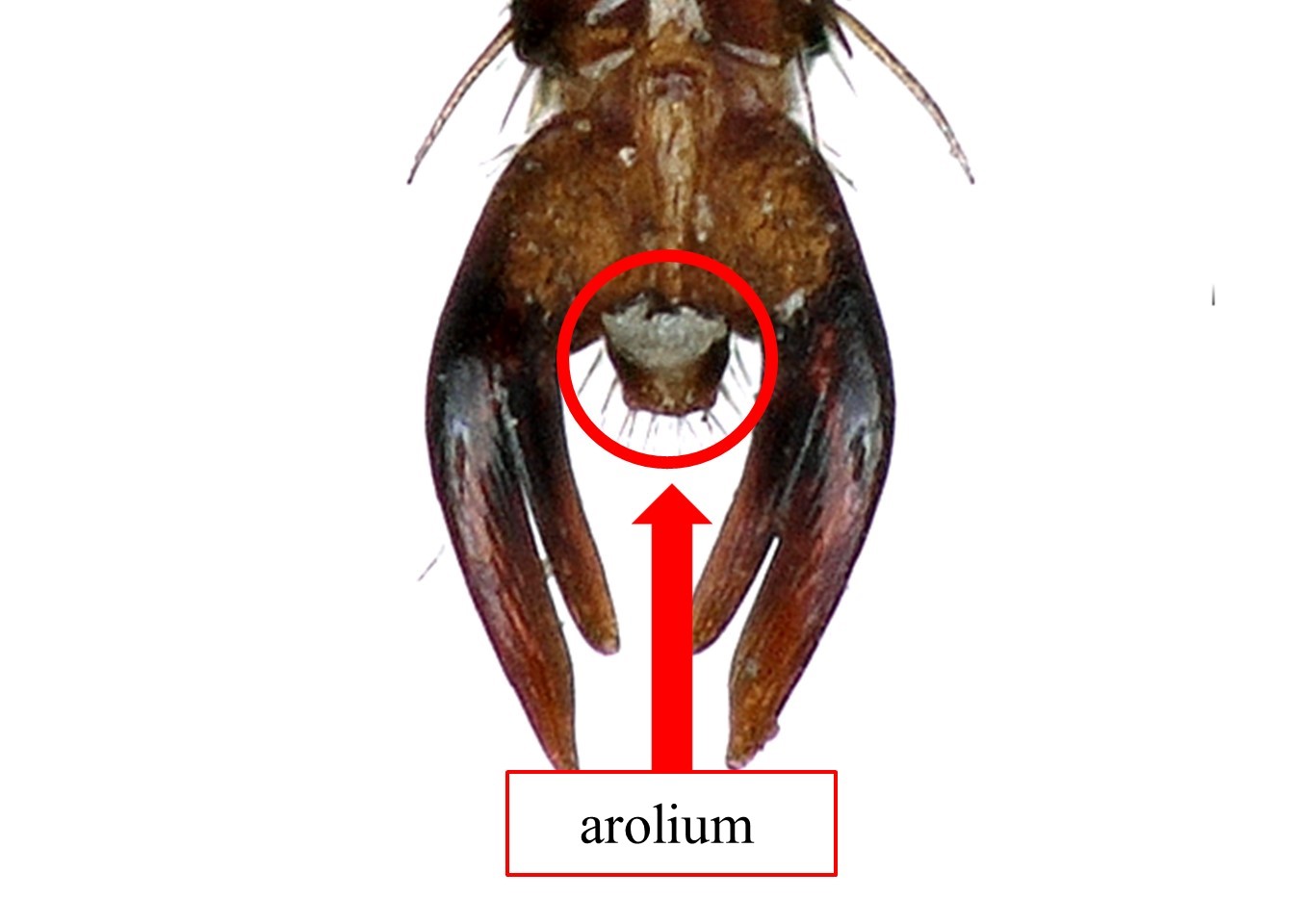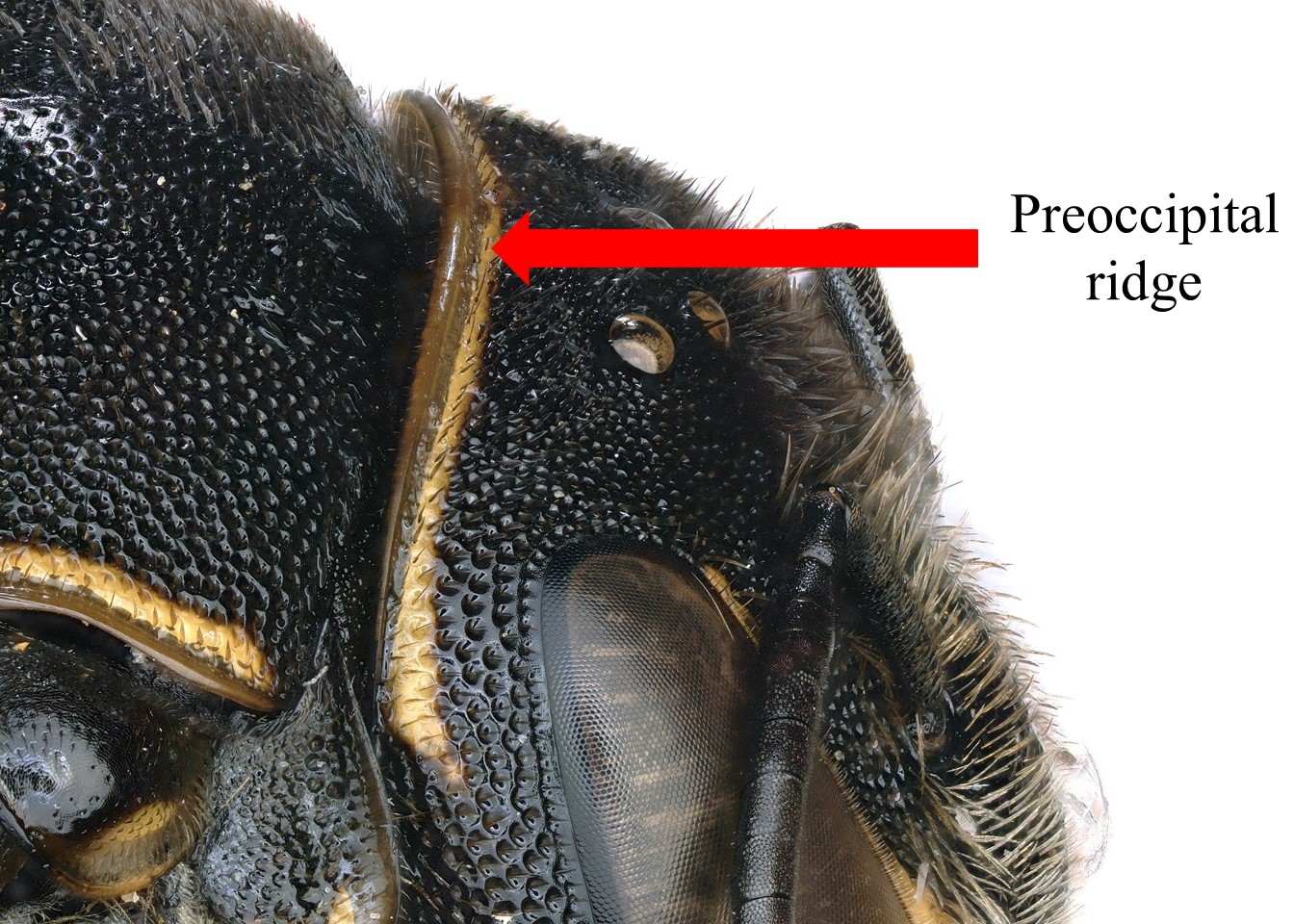Family: Megachilidae
Subfamily: Megachilinae
Tribe: Megachilini
Genus: Matangapis Baker and Engel, 2006
Subgenera: none
Common name: none
Matangapis are black to dark brown bees with apicalapical:
near or at the apex or end of any structure
bands of white hair on their tergaterga:
the segments on the top side of the abdomen, often abbreviated when referring to a specific segment to T1, T2, T3, T4, T5, T6, or T7 . It ranges in body length from 7.5–8 mm (Michener 2007Michener 2007:
. It ranges in body length from 7.5–8 mm (Michener 2007Michener 2007:
Michener, C.D. 2007. The Bees of the World (2nd ed.). Johns Hopkins University Press, Baltimore and London, 953 pp.). Matangapis was previously listed as a subgenus of Megachile (Michener 2007Michener 2007:
Michener, C.D. 2007. The Bees of the World (2nd ed.). Johns Hopkins University Press, Baltimore and London, 953 pp.). Matangapis was placed in its own genus due to the presence of aroliaarolia:
the cushion-like pad between the tarsal claws found at the ends of some bees' legs
 on all legs (Gonzalez 2008Gonzalez 2008:
on all legs (Gonzalez 2008Gonzalez 2008:
Gonzalez, V.H. 2008. Phylogeny and classification of the bee tribe Megachilini (Hymenoptera: Apoidea: Megachilidae), with emphasis on the genus Megachile. Thesis: Department of Ecology and Evolutionary Biology and the College of Liberal Arts and Science of the University of Kansas: 1-274.).
Matangapis consists of a single species, M. alticola (Michener 2007Michener 2007:
Michener, C.D. 2007. The Bees of the World (2nd ed.). Johns Hopkins University Press, Baltimore and London, 953 pp.); none are known to occur in the U.S. or Canada.
(modified from Michener 2007Michener 2007:
Michener, C.D. 2007. The Bees of the World (2nd ed.). Johns Hopkins University Press, Baltimore and London, 953 pp. unless otherwise stated)
 sharply angular dorsally, becoming carinatecarinate:
sharply angular dorsally, becoming carinatecarinate: deeply, angularly emarginateemarginate:
deeply, angularly emarginateemarginate: apicallyapically:
apicallyapically:Matangapis may be confused with Heriadopsis because they both possess aroliaarolia:
the cushion-like pad between the tarsal claws found at the ends of some bees' legs
 on the front and mid-legs. Matangapis can be differentiated by the aroliaarolia:
on the front and mid-legs. Matangapis can be differentiated by the aroliaarolia:
the cushion-like pad between the tarsal claws found at the ends of some bees' legs
 present on ALL legs (Michener 2007Michener 2007:
present on ALL legs (Michener 2007Michener 2007:
Michener, C.D. 2007. The Bees of the World (2nd ed.). Johns Hopkins University Press, Baltimore and London, 953 pp.).
There are no known invasives.
Matangapis is only known to occur in Borneo (Michener 2007Michener 2007:
Michener, C.D. 2007. The Bees of the World (2nd ed.). Johns Hopkins University Press, Baltimore and London, 953 pp.).
Distribution map generated by Discover Life -- click on map for details, credits, and terms of use.
Baker, D.B. and Engel, M.S. 2006. A new subgenus of Megachile from Borneo with aroliaarolia:
the cushion-like pad between the tarsal claws found at the ends of some bees' legs
 (Hymenoptera: Megachilidae). American Museum Novitates 3505:1-12.
(Hymenoptera: Megachilidae). American Museum Novitates 3505:1-12.
Gonzalez, V.H. 2008. Phylogeny and classification of the bee tribe Megachilini (Hymenoptera: Apoidea, Megachilidae), with emphasis on the genus Megachile. Doctoral dissertation, University of Kansas.
Michener, C.D. 2007. The Bees of the World (2nd ed.). Johns Hopkins University Press, Baltimore and London, 953 pp.